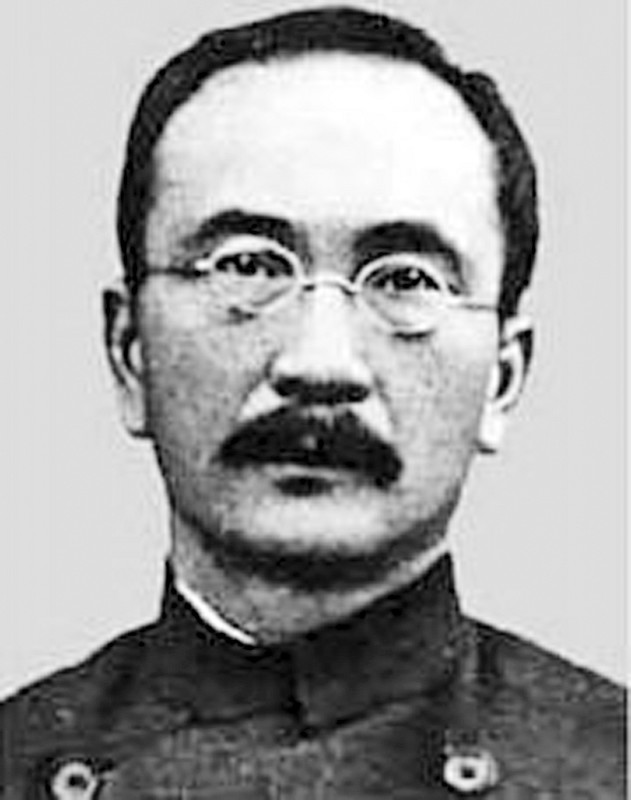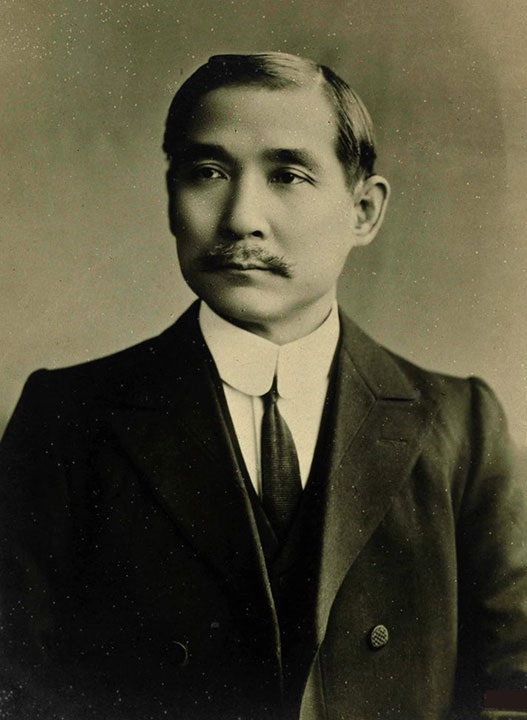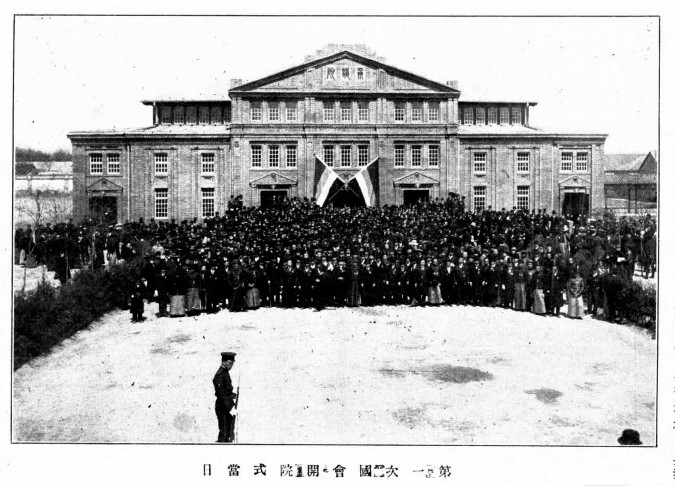|
Beiyang Government
The Beiyang government (), officially the Republic of China (), sometimes spelled Peiyang Government, refers to the government of the Republic of China which sat in its capital Peking (Beijing) between 1912 and 1928. It was internationally recognized as the legitimate Chinese government during that time. The name derives from the Beiyang Army, which dominated its politics with the rise of Yuan Shikai, who was a general of the Qing dynasty. After his death, the army split into various warlord factions competing for power, in a period called the Warlord Era. Although the government and the state were nominally under civilian control under a constitution, the Beiyang generals were effectively in charge of it. Nevertheless, the government enjoyed legitimacy abroad along with diplomatic recognition, had access to tax and customs revenue, and could apply for foreign financial loans. Its legitimacy was seriously challenged in 1917, by Sun Yat-sen's Canton-based Kuomintang (KMT) ... [...More Info...] [...Related Items...] OR: [Wikipedia] [Google] [Baidu] |
Federal Republic
A federal republic is a federation of states with a republican form of government. At its core, the literal meaning of the word republic when used to reference a form of government means: "a country that is governed by elected representatives and by an elected leader (such as a president) rather than by a monarch". In a federal republic, a division of powers exists between the federal government and the government of the individual subdivisions. While each federal republic manages this division of powers differently, common matters relating to security and defense, and monetary policy are usually handled at the federal level, while matters such as infrastructure maintenance and education policy are usually handled at the regional or local level. However, views differ on what issues should be a federal competence, and subdivisions usually have sovereignty in some matters where the federal government does not have jurisdiction. A federal republic is thus best defined in contrast ... [...More Info...] [...Related Items...] OR: [Wikipedia] [Google] [Baidu] |
Qing Yun Ge 1
The Qing dynasty ( ), officially the Great Qing,, was a Manchu-led imperial dynasty of China and the last orthodox dynasty in Chinese history. It emerged from the Later Jin dynasty founded by the Jianzhou Jurchens, a Tungusic-speaking ethnic group who unified other Jurchen tribes to form a new "Manchu" ethnic identity. The dynasty was officially proclaimed in 1636 in Manchuria (modern-day Northeast China and Outer Manchuria). It seized control of Beijing in 1644, then later expanded its rule over the whole of China proper and Taiwan, and finally expanded into Inner Asia. The dynasty lasted until 1912 when it was overthrown in the Xinhai Revolution. In orthodox Chinese historiography, the Qing dynasty was preceded by the Ming dynasty and succeeded by the Republic of China. The multiethnic Qing dynasty lasted for almost three centuries and assembled the territorial base for modern China. It was the largest imperial dynasty in the history of China and in 1790 the four ... [...More Info...] [...Related Items...] OR: [Wikipedia] [Google] [Baidu] |
Republic Of China (1912–1949)
The Republic of China (ROC), between 1912 and 1949, was a sovereign state recognised as the official designation of China when it was based on Mainland China, prior to the Retreat of the government of the Republic of China to Taiwan, relocation of Government of the Republic of China, its central government to Taiwan as a result of the Chinese Civil War. At a Population history of China, population of 541 million in 1949, it was the List of countries and dependencies by population, world's most populous country. Covering , it consisted of 35 provinces of China, provinces, 1 Special administrative regions of China#ROC special administrative regions, special administrative region, 2 regions, 12 special municipality (Republic of China), special municipalities, 14 leagues, and 4 special banners. The China, People's Republic of China (PRC), which rules mainland China today, considers ROC as a country that ceased to exist since 1949; thus, the history of ROC before 1949 is often ... [...More Info...] [...Related Items...] OR: [Wikipedia] [Google] [Baidu] |
Chinese Postal Romanization
Postal romanization was a system of transliterating Chinese place names developed by postal authorities in the late 19th and early 20th centuries. For many cities, the corresponding postal romanization was the most common English-language form of the city's name from the 1890s until the 1980s, when postal romanization was replaced by pinyin, but the system remained in place on Taiwan until 2002. In 1892, Herbert Giles created a romanization system called Nanking syllabary. The Imperial Maritime Customs Post Office would cancel postage with a stamp that gave the city of origin in Latin letters, often romanized using Giles's system. In 1896, the Customs Post was combined with other postal services and renamed the Chinese Imperial Post. As a national agency, the Imperial Post was an authority on Chinese place names. When the Wade–Giles system of romanization became widespread, some argued that the post office should adopt it. This idea was rejected at a conference held in 1906 ... [...More Info...] [...Related Items...] OR: [Wikipedia] [Google] [Baidu] |
Pan Fu
Pan Fu () (22 November 1883 – 12 September 1936) was a Chinese politician and premier of the Republic of China from 1927 to 1928 during the Beiyang government. He was the acting Minister of Finance from 24 July 1920 to 11 August 1920, and again from 11 June 1921 to 28 October 1921 when he stood in for Li Shiwei. He was finance minister in his own right from 1 October 1926 to 12 January 1927. Fu became premier and minister for transportation on 12 January 1927 and served until 3 June 1928. See also * Beiyang Government The Beiyang government (), officially the Republic of China (), sometimes spelled Peiyang Government, refers to the government of the Republic of China which sat in its capital Peking (Beijing) between 1912 and 1928. It was internationally r ... References 1883 births 1961 deaths Finance Ministers of the Republic of China Politicians from Jining Premiers of the Republic of China Republic of China politicians from Shandong {{C ... [...More Info...] [...Related Items...] OR: [Wikipedia] [Google] [Baidu] |
Tang Shaoyi
Tang Shaoyi (; 2 January 1862 – 30 September 1938), also spelled Tong Shao Yi, courtesy name Shaochuan (), was a Chinese statesman who briefly served as the first Premier of the Republic of China in 1912. In 1938, he was assassinated by the staff of the Bureau of Investigation and Statistics in Shanghai. Early life Tang was a native of Xiangshang County, Guangdong. Tang was educated in the United States, attending elementary school in Springfield, Massachusetts, and high school in Hartford, Connecticut. He later studied at Queen's College, Hong Kong, and then Columbia University in New York on the Chinese Educational Mission. He was a member of Columbia College's class of 1882 before being recalled back to China by the Qing government. Tong was a classmate and close friend of future Columbia president Nicholas Murray Butler. Career Tang was a friend of Yuan Shikai; and during the Xinhai Revolution, negotiated on the latter's behalf in Shanghai with the revolutionaries' Wu ... [...More Info...] [...Related Items...] OR: [Wikipedia] [Google] [Baidu] |
List Of Premiers Of The Republic Of China
This is a list of the Premiers of the Republic of China since 1912. The Republic of China before 1949 controlled Mainland China as well as offshore islands. The Republic of China since 1949 has only controlled Taiwan and nearby islands. The current Republic of China is usually known as Taiwan. In the country's history, the official title of the head of government has changed over time. Premiers, also known as Presidents of the Executive Yuan, are appointed by the Presidents of the Republic of China, but some premiers were even more powerful than the presidents, during the early age of the Republic of China. Some presidents were even expelled by the premiers they appointed. The title of premier in China was changed several times, so this list is divided into several sections. List Premiers of the Cabinet of the Republic of China (1912–1914) * Period: 13 March 1912 – 1 May 1914 According to the Provisional Constitution of Republic of China, which was passed in 1912 ... [...More Info...] [...Related Items...] OR: [Wikipedia] [Google] [Baidu] |
Zhang Zuolin
Zhang Zuolin (; March 19, 1875 June 4, 1928), courtesy name Yuting (雨亭), nicknamed Zhang Laogang (張老疙瘩), was an influential Chinese bandit, soldier, and warlord during the Warlord Era in China. The warlord of Manchuria from 1916 to 1928, and the military dictator of the Republic of China in 1927 and 1928, he rose from banditry to power and influence. Backed by Japan, Zhang successfully influenced politics in the Republic of China during the early 1920s. In the fall of 1924, during the Second Zhili–Fengtian War, he invaded and gained control of Peking, including the internationally recognized government, in April 1926. His appointment as grand marshal of the Republic of China in June 1927 represented the height of his success, but was quickly followed by defeat: the economy of Manchuria, the basis of his power, was overtaxed by his adventurism and collapsed in the winter of 1927; and he was defeated by the National Revolutionary Army of the Kuomintang under Gener ... [...More Info...] [...Related Items...] OR: [Wikipedia] [Google] [Baidu] |
List Of Presidents Of The Republic Of China
This is a list of the President of the Republic of China, presidents of the Republic of China. The Republic of China (1912–1949), Republic of China controlled Mainland China before 1949. In the fall of 1949, the ROC government Retreat of the Republic of China to Taiwan, retreated to Free area of the Republic of China, Taiwan and surrounding islands as a result of the takeover of the mainland by the Chinese Communist Party and founding of the China, People's Republic of China. Since 1949, the Republic of China, now commonly known as "Taiwan", has only controlled Taiwan and nearby islands. Martial law ended in Taiwan in the 1980s and Presidential elections in Taiwan, direct elections were introduced in 1996. The official name of the office in Chinese has changed several times. List Provisional Government: Beiyang Government: Nationalist to Constitutional Government: Timeline Presidential age-related data (post-1947 Constitution) Oldest living Green tex ... [...More Info...] [...Related Items...] OR: [Wikipedia] [Google] [Baidu] |
Yuan (currency)
The yuan (; sign: ¥; ; ) is the base unit of a number of former and present-day currencies in Chinese. A ''yuan'' () is also known colloquially as a ''kuai'' (; originally a lump of silver). One ''yuan'' is divided into 10 ''jiao'' () or colloquially ''mao'' ( "feather"). One ''jiao'' is divided into 10 ''fen'' (). Current usage Today, the term "Yuan" usually refers to the primary unit of account of the renminbi (RMB), the currency of the People's Republic of China. RMB banknotes start at one Yuan and go up to 100 Yuan. It is also used as a synonym of that currency, especially in international contexts – the ISO 4217 standard code for renminbi is CNY, an abbreviation of "Chinese yuan". (A similar case is the use of the terms ''sterling'' to designate British currency and ''pound'' for the unit of account.) The symbol for the yuan (元) is also used in Chinese to refer to the currency units of Japan ''(yen)'' and Korea ''( won)'', and is used to translate the currency u ... [...More Info...] [...Related Items...] OR: [Wikipedia] [Google] [Baidu] |
National Assembly (Beiyang Government)
The National Assembly () was the legislative branch of the Beiyang government during the Republican era of Chinese history. The National Assembly was first founded in 1913, following the overthrow of the previous Qing dynasty, as the first free democratic legislature in Chinese history. It was disbanded less than a year later as President Yuan Shikai assumed dictatorial power and declared himself the Emperor of China. During the Warlord Era, the National Assembly was resurrected and disbanded more than once as different warlords vied for power and legitimacy. In 1925, the National Revolutionary Army led by Kuomintang entered Beijing (Peking) and completed the Northern Expedition. The National Assembly, along with the Beiyang government, was dissolved and replaced by the Nationalist government led by Kuomintang. The KMT established a new appointed parliament call the Legislative Yuan. History Early Chinese parliament Calls for a National Assembly were part of the platfor ... [...More Info...] [...Related Items...] OR: [Wikipedia] [Google] [Baidu] |
Standard Chinese
Standard Chinese ()—in linguistics Standard Northern Mandarin or Standard Beijing Mandarin, in common speech simply Mandarin, better qualified as Standard Mandarin, Modern Standard Mandarin or Standard Mandarin Chinese—is a modern Standard language, standardized form of Mandarin Chinese that was first developed during the Republic of China (1912–1949), Republican Era (1912‒1949). It is designated as the official language of Languages of China, mainland China and a major language in the United Nations languages, United Nations, Languages of Singapore, Singapore, and Languages of Taiwan, Taiwan. It is largely based on the Beijing dialect. Standard Chinese is a pluricentric language with local standards in mainland China, Taiwan and Singapore that mainly differ in their lexicon. Hong Kong written Chinese, used for formal written communication in Hong Kong and Macau, is a form of Standard Chinese that is read aloud with the Cantonese reading of characters. Like other Sinit ... [...More Info...] [...Related Items...] OR: [Wikipedia] [Google] [Baidu] |






